mobile View, to the German Version tap the flag


- paliamentary democracy
- own name: Crna Gora
• Flags
• Historical Flags
• Meaning/Origin of the Flag
• Coat of Arms
• Historical Coats of Arms
• Meaning/Origin of the Coat of Arms
• Aircraft Roundel
• Map
• Numbers and Facts
• History
• Origin of the Country's Name
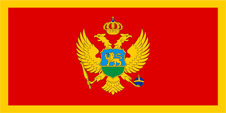
since 2004,
National, state and merchant flag,
ratio = 1:2,
Source, by:
Wikipedia (EN)





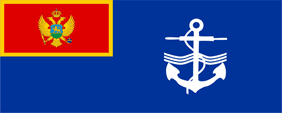
since 2010,
Naval flag,
ratio = 2:5,
Source, by:
Wikipedia (EN)




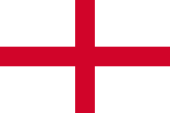
1878–1880,
Merchant flag,
ratio = 2:3,
Source, by: Flags of the World



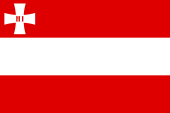
1880,
National and merchant flag,
ratio = 2:3,
Source, by: Flags of the World



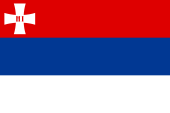
1880–1881,
National and merchant flag,
ratio = 2:3,
Source, by:
Flags of the World



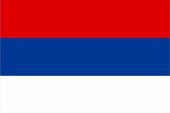
1881–1918,
National and merchant flag,
ratio = 2:3,
Source, by:
Flags of the World



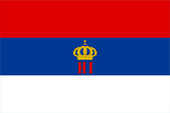
1881–1918,
Naval and war flag,
ratio = 2:3,
Source, by:
Flags of the World



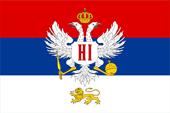
1910–1918,
State flag,
ratio = 2:3,
Source, by:
World Statesmen



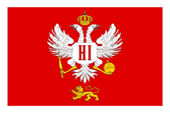
1910–1916,
Flag of the (last) King of Montenegro
Nikita (Nikolaus) I.,
ratio = 2:3,
Source, by:
World Statesmen




1941–1944,
National flag,
ratio = 2:3,
Source, by:
Wikipedia (EN)



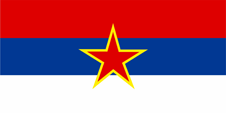
1947–1993,
Flag of Montenegro within the SFRY,
ratio = 1:2,
Source, by:
World Statesmen




1993–2004,
Flag of the country,
ratio = 1:3,
Source, by:
Wikipedia (EN)




The today's flag of Montenegro was adoped on the 12th of July in 2004. It is single-coloured red with a golden border and shows in the middle a golden twin-eagle. In the chest-shield of the eagle and below the eagle a golden going lion, a ancient Montenegran national symbol. From the country's past, red flags are known, often with a cross or with a double eagle. All these are heraldic symbols dating back to the Byzantine Empire, because Zeta – the country was former called in this way – was initially a Byzantine fiefdom. The red flag with the double eagle appears to have been preserved as the monarch's flag until modern times. It stood model for today's flag. The introduction of a flag as a national symbol was waiting in Montenegro. It was not until 1878 that white flags with a red George Cross were detected on merchant ships. After the Congress of Vienna in 1878, the country came under Austrian protection and the merchant ships were oriented towards the colours of Austria. Only a small cross in the upper corner marked the difference. Just one year later, this flag was switched to the Panslavic colors, following the model of Serbia in red-blue and white. Many Slavic nations create on the 19th century own flags – in context with a growing Slavic nationalism. Thereby played the Panslavism an important roll, a political movement of the 18th/19th century, which would unite all Slavs in one nation. The most Slavic nations however lived in this times under Austrian, Turkish or even German rule. The Panslavism saw in Russia a model, because the Russians were, apart from Serbia and Montenegro, the only free Slavic nation. In this way the colours of the Russian flag became to an idol of the Panslavists, and in the end to a colour's pattern in the designing of the flags of many Slavic nations. Those flags carried and carry except few exceptions the Russian colours white, blue and red as mutual attribute. From there this colour's combination is named "Panslavic Colours". The monarchy was ended in 1916 by the invasion of troops from Austria-Hungary during the First World War, and the king fled abroad. Montenegro participated in the First World War on the side of the Entente. The King of Serbia unified the South Slavic nations under his crown in the year 1918. In the Kingdom of Serbs, Croats and Slovenes (called Yugoslavia from 1929) Montenegro belonged to the Banovina (province) of Zeta. In the Federal People's Republic of Yugoslavia, proclaimed by Tito in 1945, the South Slavic nations were able to use their national colors (mostly combinations of Panslavic colors) on their own flags again, in their own republics. However, because of the political system, a red star had to be used in the middle of the flag. With the collapse of the socialistic system left the countries Slovenia, Croatia, Macedonia and Bosnia-Herzegovina the Yugoslav state between 1991 und 1992. In April 1992 joined the both remaining countries Serbia and Montenegro to the "Federative Republic of Yugoslavia", and on the 27th of April in 1992 the red star was removed without replacement from the national flag. The two remaining member states used equal flags in red-blue-white within the new Yugoslavia. For distinction, the flag of Montenegro was presented in the format 1:3. In 2004, the current flag of Montenegro was introduced. The Federation of "Yugoslavia" was now called "Federal Republic of Serbia and Montenegro". The federation was dissolved in 2006.
Source:
Die Welt der Flaggen,
Flaggen und Coat of arms of the Welt,
Wikipedia (EN), Volker Preuß

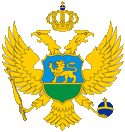
since 2004,
Coat of arms of Montenegro,
Source: Wikipedia (EN)

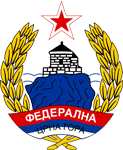
1945–1947,
Coat of arms of Montenegro,
Source, by: User:Stefke, CC BY-SA 3.0, via Wikimedia Commons
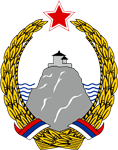
1947–1963,
Coat of arms of Montenegro,
Source, by: w:en:User:Stefke, CC BY-SA 3.0, via Wikimedia Commons
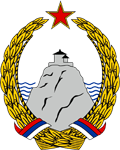
1963–1994,
Coat of arms of Montenegro,
Source, by: User:Slashme, CC BY-SA 4.0, via Wikimedia Commons
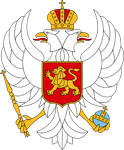
1994–2004,
Coat of arms of Montenegro,
Source: prof. Bogdan Kršić[3]([4] archived), Public domain, via Wikimedia Commons

The coat of arms Montenegro descends in the above showed form from the 19th century. Its roots has it however in the middle ages. Montenegro arised as Serbian principality out of the ruins of the after 1355 crumbled Great Serbian Empire. On its position was situated the Serbian Principality of Zeta between the 9th and beginning of the 12th century, which was a fiefdom of the Byzantian Empire. In this way it is not a random accident, that the Montenegran heraldry with the silvery double-eagle remembers the heraldry of the Byzantian Empire. As well in the religion was continued the christian-orthodox legacy of Byzantium. Montenegro's double eagle wears and weared at times a chest shield on which a golden, marching lion can be seen. Sometimes, the lion appeared on flags, outside the eagle, especially when the ruler's initials could be seen in the chest shield. Nothing is known about the origin of the eagle, possibly he is associated with the dynasty of the Njegoš-Family, which had been in power since 1782. In the socialistic Yugoslavia (1946–1992) was adoped a new, with communist symbolism furnished coat of arms. It showed Mount Lovcen in southern Montenegro, to which the name of the state goes back.
Source:
Wikipedia (EN), Volker Preuß

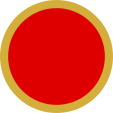
2006–2018,
Aircraft Roundel,
Source, by: Wikipedia (EN)
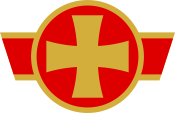
since 2018,
Aircraft Roundel,
Source, by: Wikipedia (EN)

Location:
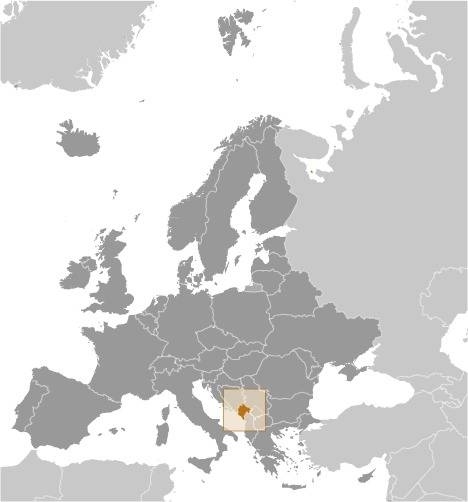
Source: CIA World Factbook
Map of the country:
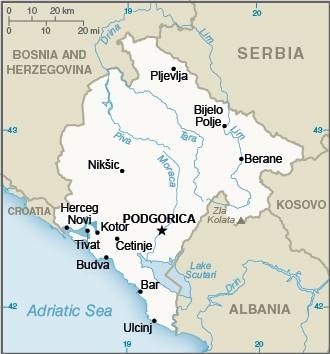
Source: CIA World Factbook
The countries of former Yugoslavia:
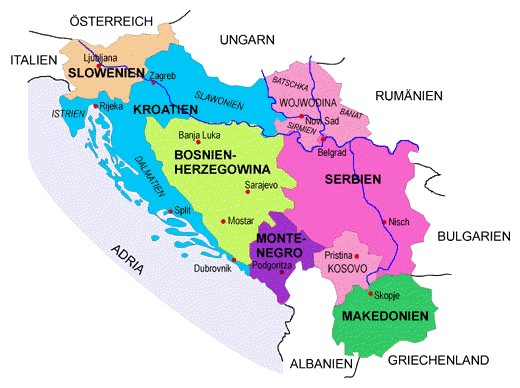
Map: Volker Preuß

Area: 5.333 square miles
Inhabitants: 621.000 (2020), thereof 45% Montenegran Serbs, 29% Serbs, 9% Bosniaks, 5% Albanians
Religions: 72% Serbian-Orthodox Christian, 16% Muslim
Density of Population: 116 inh./sq.mi.
Capital: Podgorica (name 1946–1992: Titograd), 151.000 inh. (2011)
official Language: Montenegrin
other Languages: Serbian, Croatian, Bosnian, Albanian
Currency: 1 Euro (EUR, €) = 100 Cent
Time Zone: GMT + 1 h
Source:
Wikipedia (D)

antiquity · settlement by Thrakian and Illyrian tribes
33–29 B.C. · Roman conquest
395 · at the partition of the Roman Empire comes the today's Montenegro to the East Roman Empire (Byzantium)
6th/7th century · immigration of the Serbs, nascence of the Serbian principalities of Zeta, Bosnia and Rashka (Rascia) as Byzantian fiefdoms
1040 · Zeta enforces its independence from Byzantium
1077 · Zeta becomes a Kingdom
1090 · Zeta unites Bosnia and Rashka under it's leadership
1138 · Zeta loses Bosnia and Rashka again
1168 · Rashka becomes a Byzantian fiefdom
1180 · Rashka gets independent from Byzantium
1183 · Rashka takes over the power in Zeta
1217 · Rashka gets levied to the Kingdom of Serbia
13th/14th century · Serbia conquers Macedonia and Bosnia, Epirus, Thessalia and Albania
1346 · Stephan Dusan gets crowned to the "Emperor of the Serbs and Greeks"
1355 · death of Emperor Stephan, the Great Serbian Empire disintegrates into particular states, in Zeta seizures the power the dynasty of the Balshitshi
1371 · the Turks strike the Serbs near the Maritza River
1389 · the Turks strike the Serbs on the Amselfeld, Serbia becomes tributary, Zeta can keep its independence
1421 · the dynasty of the Balshitshi ends
1427 · in Zeta seizures the power the dynasty of the Tchernojevichi
1499 · the Turks succeed in conquest of the plains of Zeta, Zeta accepts a nominal Ottoman supremacy
ca. 1500 · on the coast invading Venetians use for the Principality of Zeta the word Montenegro ("Montagna negra" – originally was meaned the because of its basalt rocks "Black Bountain" named Lovcen Mountain in the south of the country)
1516 · the dynasty of the Tchernojevichi ends
1516–1697 · the bishops of Tchetinje have the power in the country
1697 · the Metropolit Danilo Petrovic Njegoš (= archbishop Danilo, from the Petrovic family, from the tribe of the Njegoš) nominates hisself to the Vladike (spiritual and secular Lord of Montenegro), and establishes thus the monarchy again
1685 · Montenegro is independent from the Ottoman Empire
1798 · the Turkish Sultan recognizes the Vladike Peter II. Njegos as Prince of Montenegro
1852 · the Vladike Danilo Njegoš transforms Montenegro into a secular principality and ties it politically to Russia
1876 · war of Montenegro against the Ottoman Empire
1877–1878 · Montenegro joins in the Russian-Turkish War, substantial territorial winnings
1878 · Berlin Congress, Montenegro gets awarded furthermore territories, convergence to Austria-Hungary
1905 · Prince Nicolaus introduces a constitution
1910 · Montenegro gets proclaimed to a kingdom
1912–1913 · Montenegro joines in the Balkan Wars, substantial substantial territorial winnings
1914 · Montenegro joines in the First World War on the side of the Entente
1916 · Austria-Hungaryn occupation, the King flees abroad
1918 · the monarchy gets abolished, Montenegro becomes a part of the "Kingdom of the Serbs, Croats and Slovenes", which was renamed in 1929 into Yugoslavia, Macedonia becomes part of the Province of Zeta
1941 · Yugoslavia gets dissolved during the Second World War, Montenegro is independet until 1944
1941–1946 · Yugoslavia is during the Second World War location of a merciless partisan and civil war between communists (under J.P.Tito), republicans, monarchists and nationalists, the communists had exulted
29th of November in 1945 · proclamation of the "Federative People's Republic of Yugoslavia" by Tito
31st of January in 1946 · proclamation of the People's Republic of Montenegro (within communist Yugoslavia)
11th of April in 1963 · proclamation of the Socialist Republic of Montenegro (within communist Yugoslavia)
3rd of August in 1991 · proclamation of the Republic of Montenegro (within Yugoslavia)
1991–1992 · Yugoslavia dissolves into its particular states
27th of April in 1992 · Serbia and Montenegro proclaim the „Federal Republic of Yugoslavia”
1991–1995 · war between Yugoslavia and Croatia/Bosnia-Hercegovina
4th of February in 2003 · new constitution, Yugoslavia is replaced by the Federal Republic of Serbia and Montenegro
21st of May 2006 · plebiscite about a separation from Serbia, 55,4% agreement
13th of July 2006 · declaration of independence
Source:
Atlas zur Geschichte,
Wikipedia (D),
World Statesmen

Venetians invading the coast used the name Montenegro for the Principality of Zeta ("Montagna negra"). This originally referred to Mount Lovcen in the south of the country, called "Black Mountain", because of its black basalt rock.
Source:
Atlas der wahren Namen


![]()



























